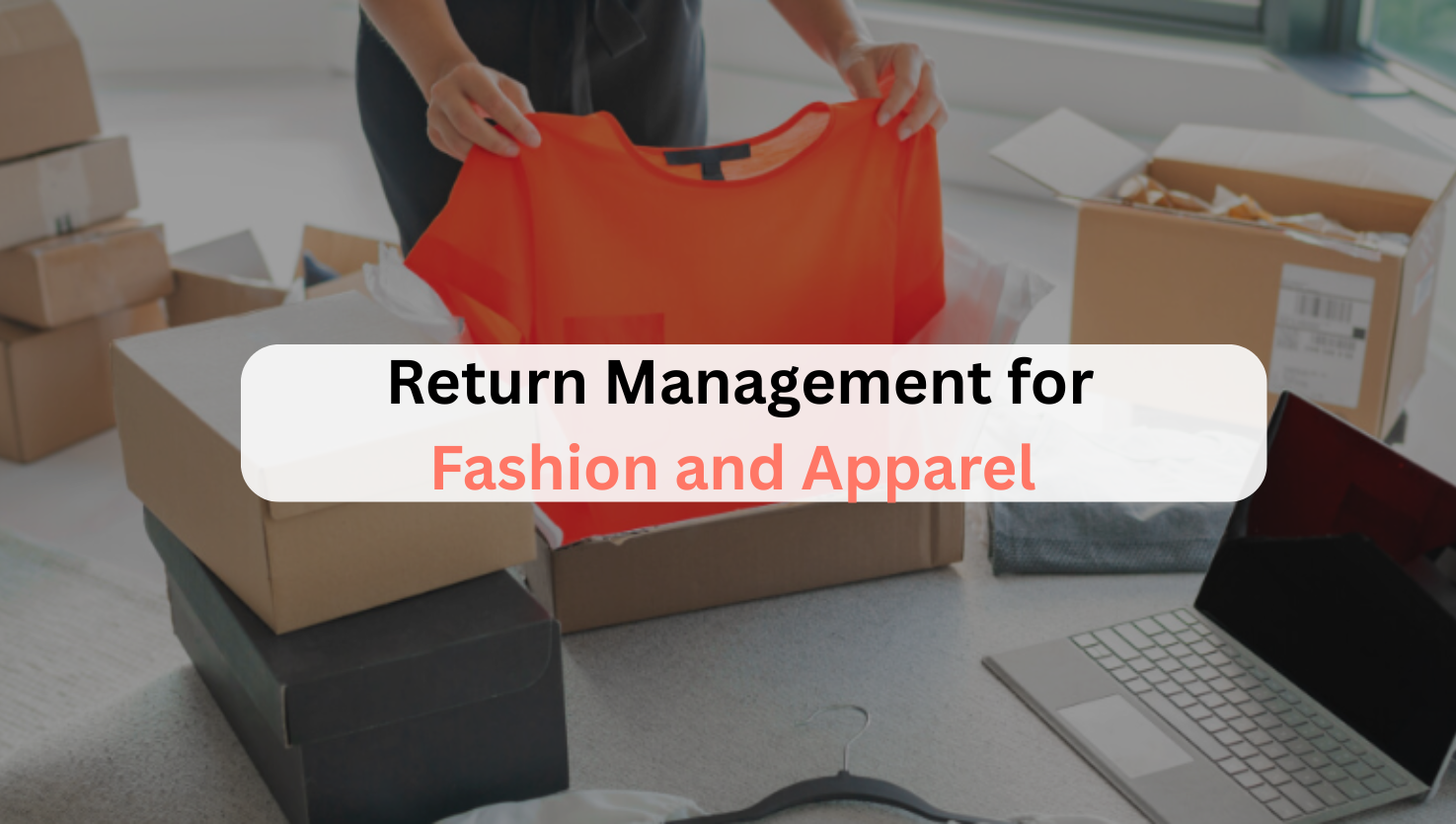Returns Management in Fashion Retail: Challenges, Processes & Solutions
Returns management in fashion retail refers to the end-to-end process of handling products sent back by customers, from return initiation and collection, through inspection and sorting, to their final outcome, whether that’s resale, recycling, donation, or disposal.
The reason this matters so much in fashion is because the industry faces some of the highest return rates in retail. Online apparel, for instance, sees return rates of nearly 30–40%, three times higher than in-store purchase. Customers often “bracket” by ordering multiple sizes or colors and sending most of them back. Add inconsistent sizing across brands, misleading product images, and even return fraud like “wardrobing,” and the scale of the problem becomes clear.
As McKinsey highlights, managing returns isn’t just about saving money on logistics anymore. It can actually boost customer loyalty, protect margins, and strengthen brand reputation. A smooth, hassle-free return experience can turn a one-time buyer into a repeat customer, while a poor experience can drive them straight to a competitor.
In this blog, we’ll look at why fashion returns are so complex, the biggest challenges retailers face, and the strategies leading brands use to reduce returns, streamline reverse logistics, and make the entire process more sustainable.
What Is the Return Process in Retail
The return process in fashion retail isn’t just about taking back a product, it’s a journey that shapes how customers feel about a brand. A smooth return can build trust and loyalty, while a clumsy one can drive shoppers straight to competitors. Here’s how it usually works:
Return Initiation – It all begins when a customer decides to send something back. This could be done online through a simple portal, via an app, or even in-store. The easier this step is, the better the experience. As Uphance points out, giving customers self-service options here saves time for both sides.
Collection & Shipping – Once approved, the product needs to get back to the retailer. That might mean a store drop-off, mailing it back with a prepaid label, or scheduling a pickup. Offering flexibility makes a huge difference, Reverselogix notes that this convenience is often what keeps customers happy.
Inspection & Sorting – After the item arrives, it’s carefully checked for quality and authenticity. Fashion retailers need to know: can it go back on the shelf, or was it worn once and returned? According to McKinsey, automation tools like RFID and smart sorting can make this step faster and more cost-efficient.
Disposition – This stage decides the product’s future. Depending on its condition, it could be restocked, refurbished, resold, donated, or recycled. Reverselogix emphasizes that sustainable approaches here, like resale or recycling, help retailers reduce waste and environmental impact.
Refund/Exchange – Finally, the customer gets their money back or swaps the product. This is the most sensitive step, delays can frustrate shoppers quickly. In fact, Reverselogix reports that 81% of customers will move to a competitor if they face a poor returns experience.
Returns are inevitable in fashion retail, but how brands handle them makes all the difference. A smooth, transparent, and sustainable returns process not only reduces costs but also builds customer trust, and that’s what keeps shoppers coming back.
What Is the Return Rate for Fashion?
Fashion consistently leads the way when it comes to e-commerce returns. On average, 30–40% of online apparel orders are sent back, which is significantly higher than the roughly 10% return rate seen in physical stores (ClickPost). This gap highlights the challenges customers face when buying clothes online, such as sizing issues, fabric feel, or color mismatches. For brands, these returns translate into higher logistics costs and operational strain. At the same time, managing returns efficiently has become a critical part of customer experience, how a brand handles returns can make or break customer loyalty. With online shopping booming, retailers need smarter return strategies to stay competitive and retain trust.
Key drivers include:
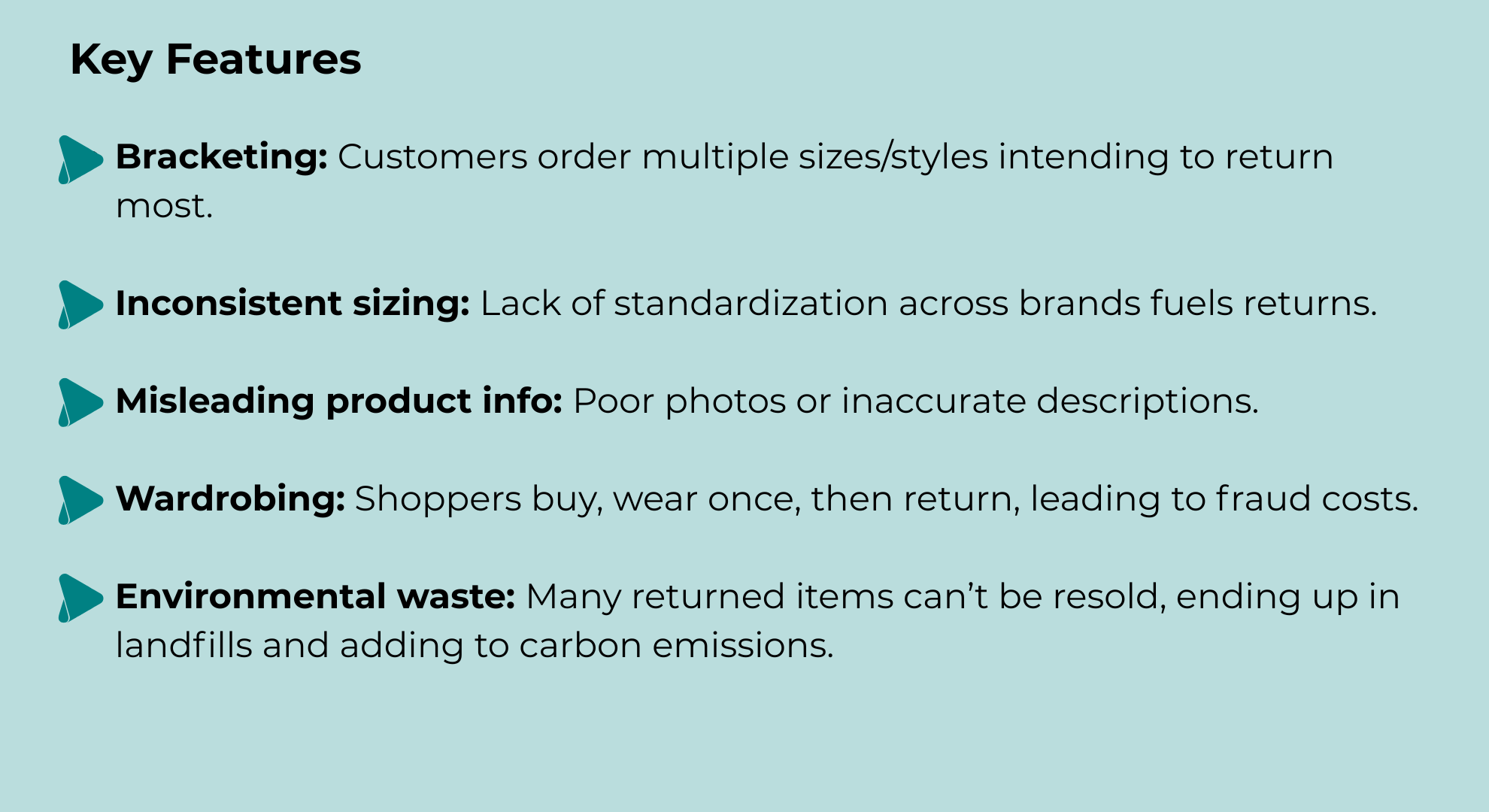
How to Manage Returns Effectively
Returns are an inevitable part of e-commerce, especially in sectors like fashion and electronics. Handling them efficiently is not just about cutting costs, it’s about keeping customers happy, protecting brand reputation, and embracing sustainable practices. A well-structured returns strategy can turn what seems like a challenge into a competitive advantage, helping businesses retain loyal customers while optimizing operations.
To make it easy to follow, here’s a structured approach to managing returns effectively:
1. Returns Prevention
The best way to manage returns is to prevent them in the first place. Clear product descriptions, accurate sizing charts, high-quality images, and AI-powered recommendations help customers make the right choice, reducing mismatched expectations and defect-related returns.
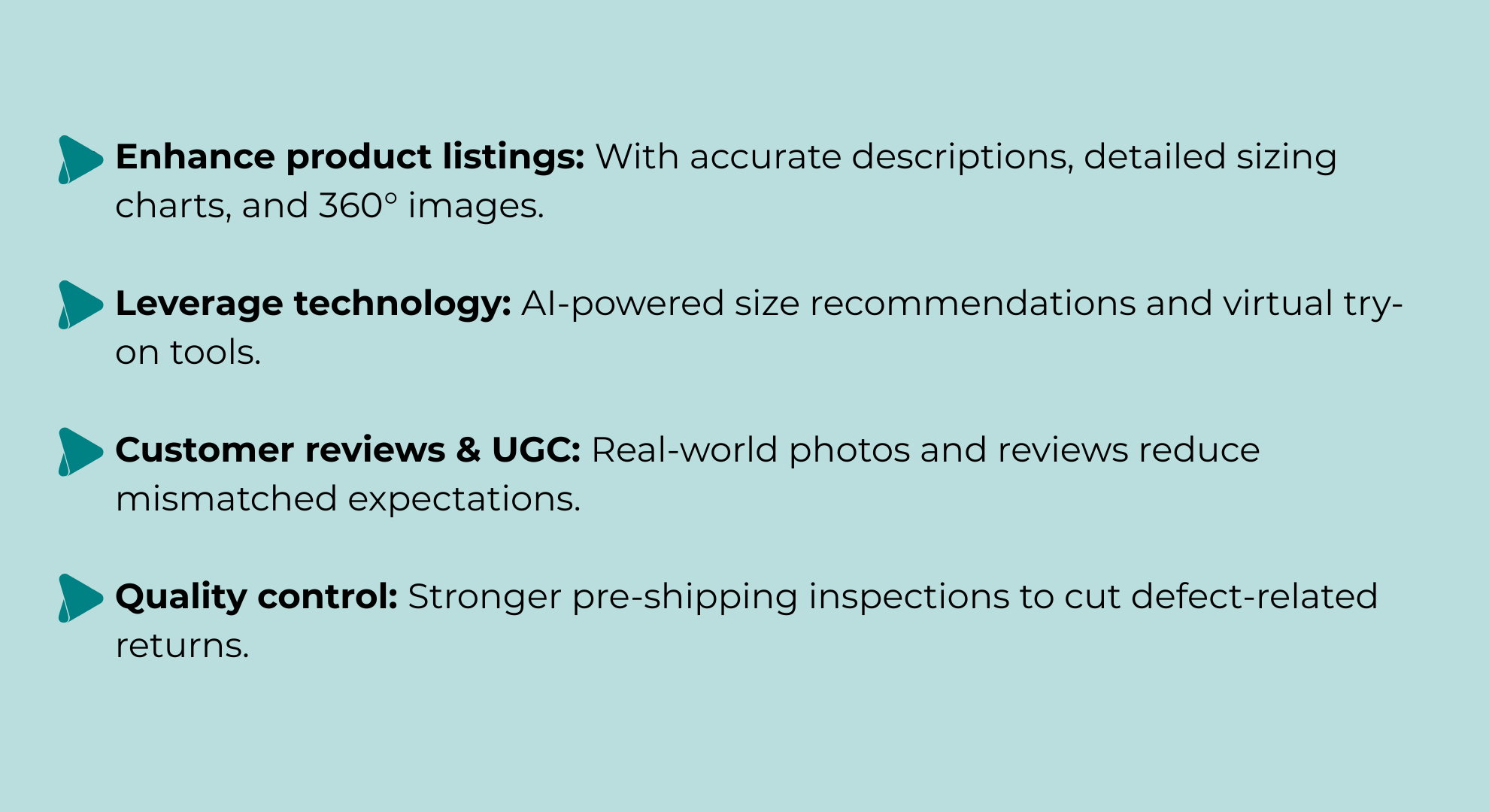
2. Optimizing the Returns Process
Even with prevention, some returns are inevitable, so having a smooth and flexible process is key. Simplified initiation, multiple return options, automated workflows, and fast refunds enhance customer satisfaction while keeping operational costs under control.
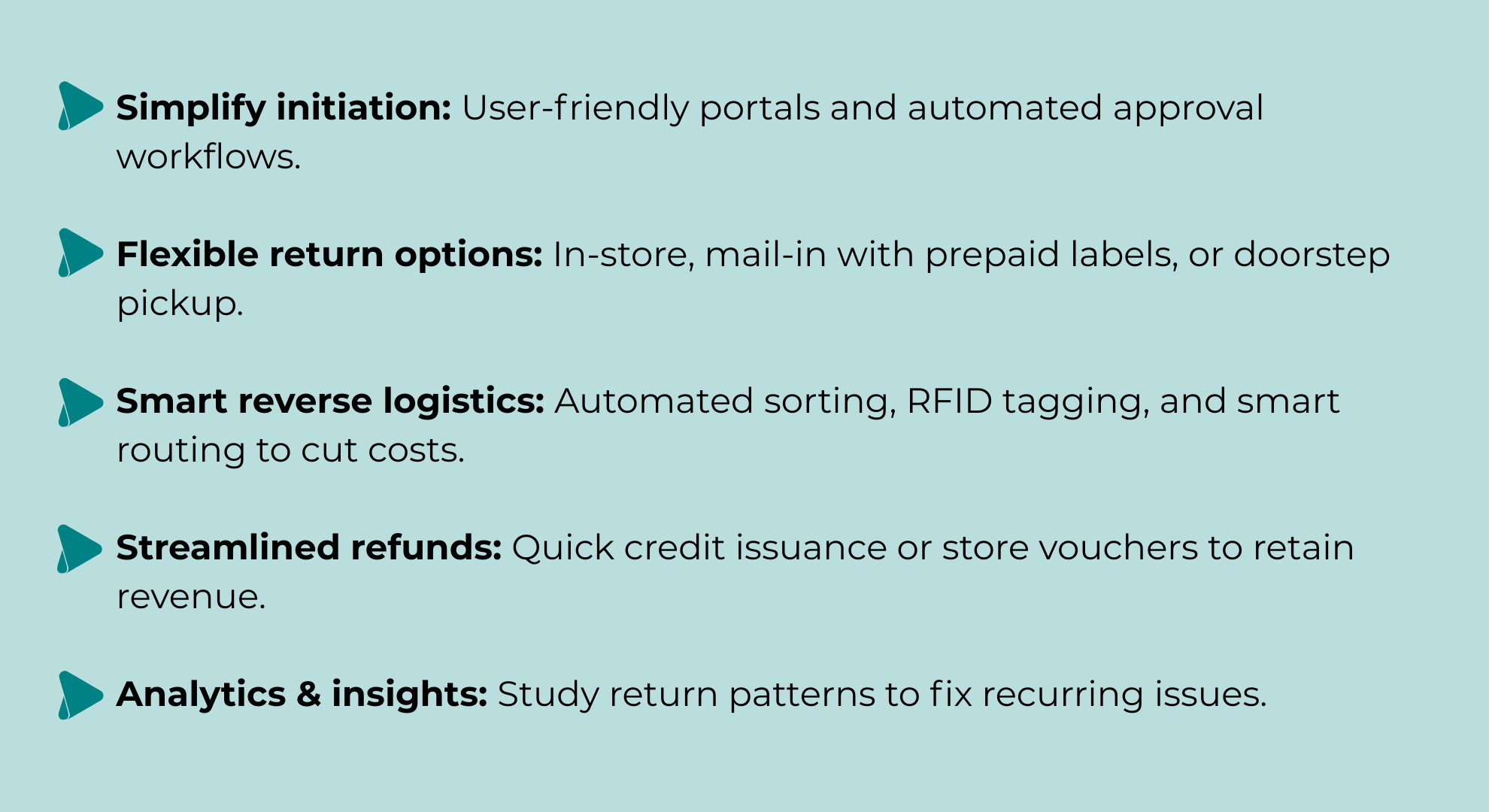
3. Sustainable Returns Solutions
Returns don’t have to mean waste. By embracing resale, refurbishment, recycling, and regional processing, businesses can reduce environmental impact, extend product life, and even create new revenue opportunities while supporting circular economy principles.
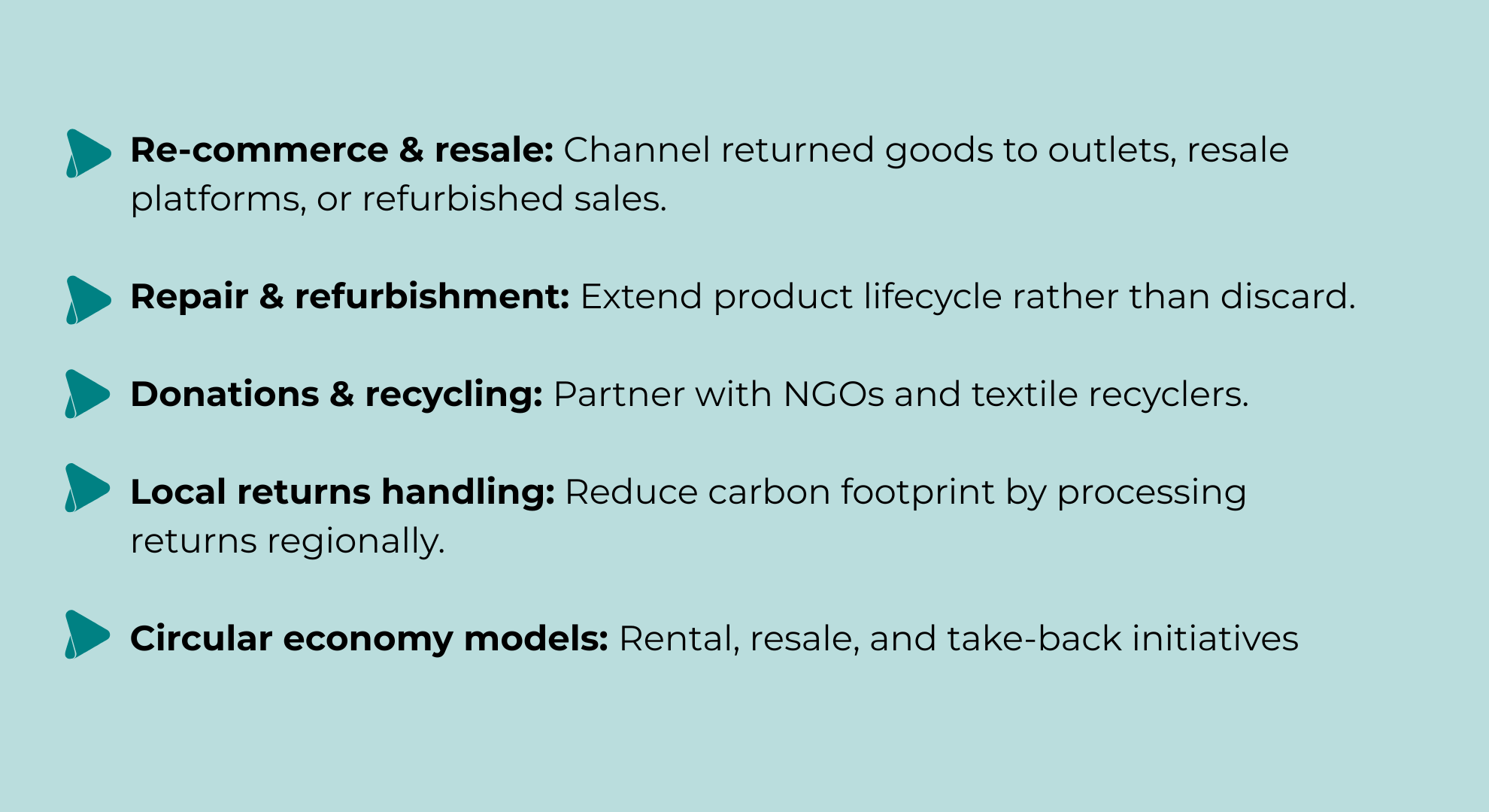
Top Challenges in Fashion & Apparel Return Management (and How to Tackle Them)
Managing returns in fashion e-commerce is no small feat. High return rates, slow processing, fraud, and sustainability concerns are all part of the challenge. A smart returns strategy not only protects margins but also keeps customers happy and loyal. Here’s a clear look at the major challenges and practical solutions:
| Challenge | Why It Happens | Smart Solutions |
| High return rates | Sizing inconsistencies, unclear product info, and try-before-buy behavior | – AI-driven size recommendations & virtual try-ons
– Detailed product descriptions & authentic reviews – Gentle return disincentives for habitual returners |
| Slow & costly return processing | Manual handling delays refunds and frustrates customers | – Automated return approvals
– Centralized returns management system – Smart routing to nearest centers |
| Reverse logistics complexity | Fast fashion turnover and multiple warehouses lead to stock mismatches and inefficiencies | – AI-powered return routing
– Real-time automated restocking – Optimized carrier & logistics planning |
| Fraud & return abuse (wardrobing) | Customers wear items and return them, or fake damages, causing losses | – AI-driven fraud detection
– Serial returner monitoring – Stricter policies for high-risk items |
| Delayed refunds & poor experience | Slow refunds increase churn and chargeback risks | – Instant AI-powered refunds
– Multiple refund/exchange options – Proactive communication via SMS/email |
| Sustainability & waste concerns | Returned items often end up as waste due to damage, hygiene, or obsolescence | – Resale & re-commerce programs
– Sustainable return policies (credits/donations) – Recycling & circular economy partnerships |
Effectively managing returns in fashion is no longer just an operational task, it’s a strategic advantage. Brands that combine smart prevention, streamlined processes, and sustainable solutions can not only reduce costs but also enhance customer loyalty and strengthen their reputation. By tackling challenges head-on with technology, clear policies, and eco-conscious practices, fashion retailers can turn returns from a burden into an opportunity for growth and trust-building.
How eShipz Optimizes Fashion & Apparel Industry Returns Management
In the fashion and apparel sector, managing returns effectively is crucial for maintaining profitability and customer satisfaction. eShipz offers a comprehensive logistics automation platform designed to streamline returns processes, enhance customer experiences, and reduce operational costs.
- Smarter Returns Prevention
eShipz’s AI-powered solutions proactively address common return drivers:
- AI-Driven Size Recommendations: Utilizing advanced algorithms, eShipz provides personalized size suggestions, helping customers select the right fit and reducing size-related returns.
- Enhanced Product Information: Detailed product descriptions, high-quality images, and customer reviews ensure customers have accurate expectations, minimizing the likelihood of returns due to mismatched expectations.
- Streamlined Returns Process
eShipz simplifies the returns journey for both businesses and customers:
- ReturnEase Portal: A branded, self-service portal that allows customers to initiate returns effortlessly, enhancing their experience and reducing support workload.
- Smart Reverse Logistics: Automated routing and real-time tracking ensure returned items are processed efficiently, minimizing delays and associated costs.
- Sustainable Returns Management
eShipz promotes eco-friendly practices in returns handling:
- ReDelivR: An intelligent system that identifies failed deliveries and attempts redelivery, reducing the need for returns and associated waste.
- Circular Economy Initiatives: Partnerships with recycling and resale platforms help divert returned goods from landfills, supporting sustainability efforts.
- Advanced Analytics for Continuous Improvement
eShipz’s AI-powered dashboard provides actionable insights:
- Returns Analytics: Track return reasons, identify patterns, and implement corrective actions to reduce future returns.
- Performance Monitoring: Assess carrier performance and logistics efficiency to optimize the returns process continually.
- Real-Time Customer Engagement
Maintaining communication with customers throughout the returns process is vital:
- PostShip Engage: Facilitates proactive updates and engagement, ensuring customers are informed and satisfied with the returns experience.
By integrating eShipz’s solutions, fashion and apparel brands can simplify and streamline their returns processes. Customers enjoy a smoother, more transparent return experience, boosting satisfaction and loyalty. At the same time, businesses reduce operational costs and improve overall efficiency.
Why Returns Management Is the Future of Fashion Retail
In today’s fast-paced fashion market, returns aren’t just a cost, they’re a loyalty lever. Brands that treat returns as an extension of the customer journey gain an edge, while those who ignore them risk losing both revenue and trust. Mastering returns means combining smart technology, streamlined processes, and circular economy practices to create convenience for shoppers, efficiency for operations, and sustainability for the planet. The winners in this space are those who act now, transforming returns from a burden into a strategic advantage before competitors do.
Take charge of your returns today: Discover how eShipz helps fashion brands simplify returns, reduce costs, and delight customers at every step. Explore more here.

